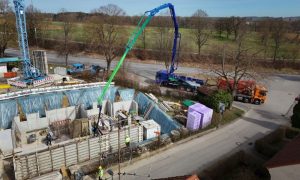Exploring the potential of technology and project delivery methods for productivity in AEC
Parsons’ Nour Kassassir asks whether the project delivery methods chosen by project owners are holding us back?

Approved Content
![]()
The architecture, engineering, and construction (AEC) industry employs 7% of the world’s population, with an approximate total annual spend of $10 trillion, a significant portion of which is going to waste. Numerous pieces of research conducted by reputable professional services companies have clearly shown that the AEC industry is at the lowest end of the productivity spectrum (one level higher than the agriculture industry). Research has showed that the productivity of the AEC industry has severely stagnated for decades. Why is that? Does the root cause relate to people, processes, technology, or a combination thereof?
Ernst & Young conducted a survey in 2017, asking respondents what issues kept them up at night. The companies surveyed represented the AEC industry value chain (general contractors; infrastructure providers; building materials; engineering, procurement, construction, and installation companies; designers; homebuilders; and developers). The survey focused on the key areas of digital strategy and readiness, digital transformation, innovation, digital tools and systems, and cybersecurity. The respondents’ top five issues tie directly to deliverables: (1) the risk management of construction projects, (2) the cost management of projects, (3) safety, (4) the acquisition of staff and employees, and (5) scheduling/time management. Technology can certainly provide opportunities to manage these issues efficiently when implemented as part of an overall digital strategy. Using parametricism, computational design, artificial intelligence, and generative design tools, coupled with the computing power of systems and the cloud, engineers are now able to explore numerous design options (optioneering) that were not before possible to explore. A recent relevant example is the Museum of the Future, in Dubai, where generative design tools were used to select the best sustainable solution.
I think the root cause of the problem related to the AEC industry being so slow in advancing is not people, nor technology, although both play pivotal enabling roles in the successful delivery of design and construction projects. In my opinion, the root cause of the problem is the project delivery method chosen by project owners. The most common project delivery methods in the AEC industry are design-bid-build, design-build, and construction management at-risk. Modern infrastructure projects are complex, and the relationships between the owners, their customers, and their contractors have made it all but impossible to transfer significant risks in the delivery process to contractors. Attempts to transfer these risks through the contract usually lead to them being priced into tenders and passed on to subcontractors. When adverse events arise during the project, it is rare for the circumstances to exactly match those foreseen in the contract, which leads to lengthy disputes between the parties.
Perhaps a closer look at delivery methods can help. I believe integrated project delivery (IPD) is an effective project delivery method that has a better chance of achieving better results in delivering projects on schedule and on budget, with the best outcome for the owner, while at the same time allowing technology to be efficiently integrated early on. IPD is more than just a contractual vehicle; it is a collaborative approach to delivery in which there’s mutual trust among the team members and in which inefficiencies are avoided. The following are the three major benefits of IPD for an owner to consider when choosing a project delivery method:
- Increased collaboration. Because all involved parties are one legal entity, whether by partnership agreements or multiparty contracts, there is increased project transparency and integrated financial interests. The team can freely share documents without legal or proprietary risk, increasing overall collaboration within the team. Due to the high level of teamwork, often early in the project, building information modelling and IPD typically go hand in hand.
- Shared risk and liability. The risk, responsibility, and liability for project delivery are spread equally among the primary parties. However, shared risk requires a high level of trust between parties as well as a high level of owner involvement throughout the IPD process.
- Aligned goals. Each party in a typical construction project has its own goals and objectives. For example, the architect may want the most creative and innovative design. The owner wants the best outcome at the cost paid and to be on schedule. The contractor wants to deliver the proposed design within the budget and schedule parameters. With IPD, the goals of the project are aligned because all parties work together from the beginning, allowing the team to focus on the complete project outcome rather than individual success.
What is the AEC industry doing to address the productivity issue?
Organisations from all levels of the supply chain agree that the infrastructure sector’s current operating model is broken. Too often, projects are delivered over budget, past deadline, and below par. In the UK, the Institution of Civil Engineers has launched Project 13 to address the industry’s productivity issue. Project 13 is an industry-wide change programme designed to radically reshape the nature of project delivery, moving from traditional transactional arrangements to an enterprise model to boost U.K. construction’s flagging productivity levels and to provide long-term value. Project 13 has developed a commercial handbook that outlines the commercial principles that underpin an enterprise and the four steps to developing a commercial strategy (https://www.ice.org.uk/news-and-insight/project-13). Project 13 is an excellent initiative that focuses on addressing the root causes of poor productivity in the AEC industry.
In conclusion, technology and advancements in technology are enablers that support efficient project delivery. However, technology is not and will never be the silver bullet that addresses the productivity of any industry. Currently, technology is nibbling at the edges of the productivity issue of the AEC industry, wherein successes achieved through technological advancements are tactical at best. Using technology as an enabler rather than a solution, initiatives such as Project 13, in the U.K., can make a step change in the transformation of our industry.
This article was authored by Nour Kassassir, Vice President and Business Technology Services Director, Parsons MEA





















